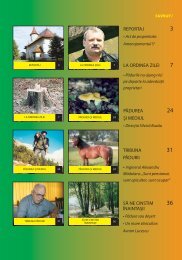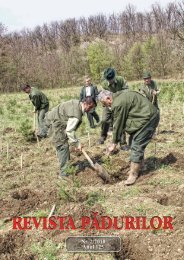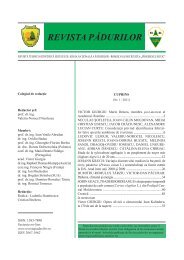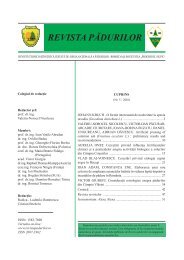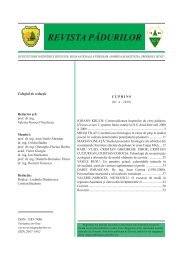şi prof.dr. W. Zwölfer - Revista Pădurilor
şi prof.dr. W. Zwölfer - Revista Pădurilor
şi prof.dr. W. Zwölfer - Revista Pădurilor
Create successful ePaper yourself
Turn your PDF publications into a flip-book with our unique Google optimized e-Paper software.
Table 3<br />
Mean height and height corresponding to the median diameter of basal area of initial, marked and remaining trees<br />
Species<br />
European beech<br />
Hornbeam<br />
Other broadleaves<br />
Mean and (min-max) height, m<br />
Initial<br />
trees<br />
17.7<br />
(11.5-22)<br />
16.8<br />
(11.5-20)<br />
19.4<br />
(15.5-<br />
22.5)<br />
Marked<br />
trees<br />
16.7<br />
(11.5-21)<br />
16.7<br />
(11.5-20)<br />
19.4<br />
(15.5-<br />
22.5)<br />
The character of mixed thinning (but mostly from<br />
below) is obvious also in the case of mean heights<br />
that have increased insignificantly for remaining tre-<br />
es (e.g., from 19.1 m up to 19.3 m of hg of European<br />
beech trees).<br />
The stand volume is much higher than the one<br />
from the management plan + increment/5 years (168<br />
cu.m/ha) and reaches about 298 cu.m/ha. The standing<br />
volume of initial trees is composed of 75%<br />
European beech, 9% hornbeam and 16% other broadleaves<br />
(table 4).<br />
Table 4<br />
Volume of initial, marked and remaining trees<br />
Species<br />
Volume<br />
Initial trees Marked trees Remained trees<br />
cu.m/ha % cu.m/ha % cu.m/ha %<br />
European<br />
beech<br />
222.0 75 21.9 35 200.1 85<br />
Hornbeam 27.1 9 17.2 28 9.9 4<br />
Other<br />
broadleaves<br />
48.8 16 23.3 37 25.6 11<br />
Total 297.9 100 62.4 100 235.5 100<br />
As the quality of pioneer species (silver birch and<br />
goat willow) is low, they can be used only for firewood<br />
so their gradual elimination by thinning to improve the<br />
Remaining<br />
trees<br />
19.2<br />
(15-22)<br />
Height corresponding to the median<br />
diameter of basal area hg, m<br />
Initial<br />
trees<br />
Marked<br />
trees<br />
Remaining<br />
trees<br />
19.1 17.1 19.3<br />
- 17.6 17 17.5<br />
- 20.7 20.7 20.7<br />
stand quality and approach the target species composi-<br />
tion (90% European beech 10% other tree species) is<br />
strongly advised.<br />
Regarding the hornbeam, it represents only 9% of<br />
standing volume and is located especially in the lower<br />
canopy. As its trees protect the lower bole of European<br />
beech against the occurrence of epicormic branches or<br />
sun-scorches after the sudden exposure of boles to sun-<br />
light following heavy thinning, they should be removed<br />
only if competing with the dominant species in the up-<br />
per canopy or rubbing the boles of final crop trees.<br />
Considering the thinning marked by the field fo-<br />
resters of Covasna Forest District, three issues are to be<br />
considered:<br />
a. The intensity of interventions varies between<br />
21% (by volume), 22% (by basal area) and 29% (by<br />
number of trees). It is a heavy thinning (intensity higher<br />
than 16% in all cases) but mostly from below, removing<br />
especially trees from the small diameter classes (most-<br />
ly less than 16 cm dbh – figure 1) and heights<br />
20 REVISTA PĂDURILOR • Anul 126 • 2011 • Nr. 2




